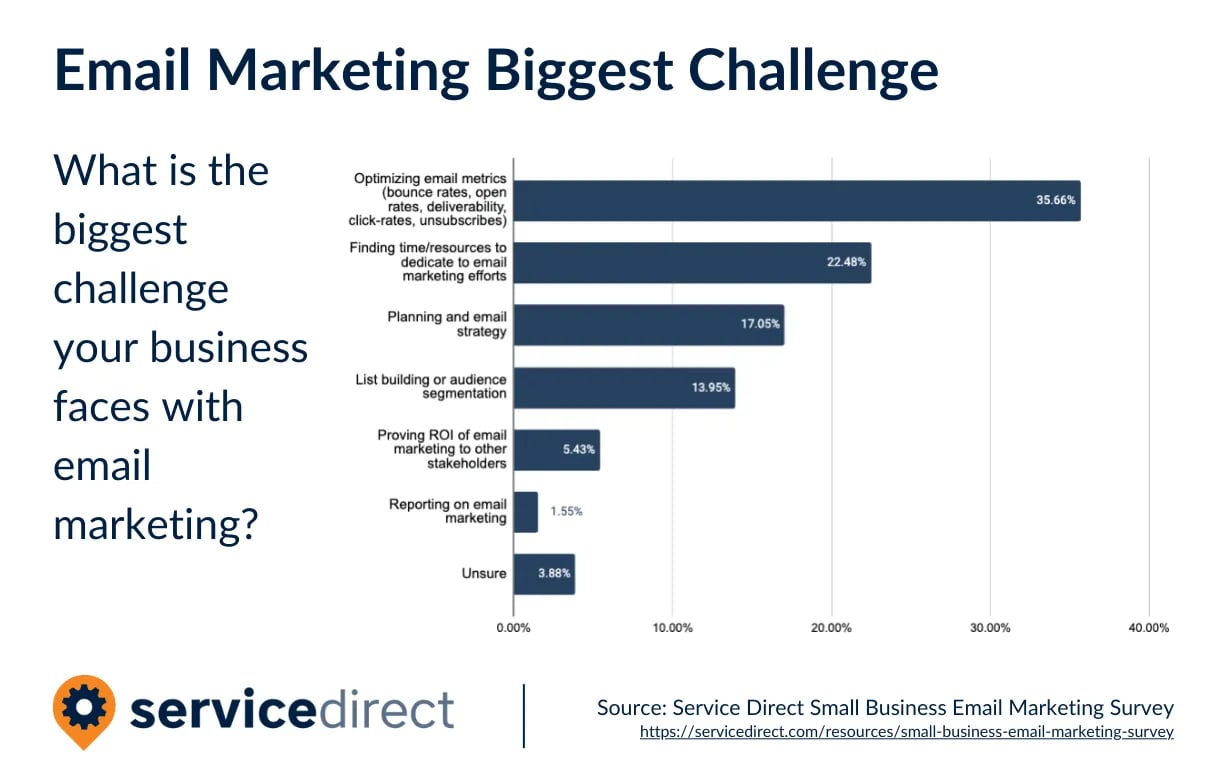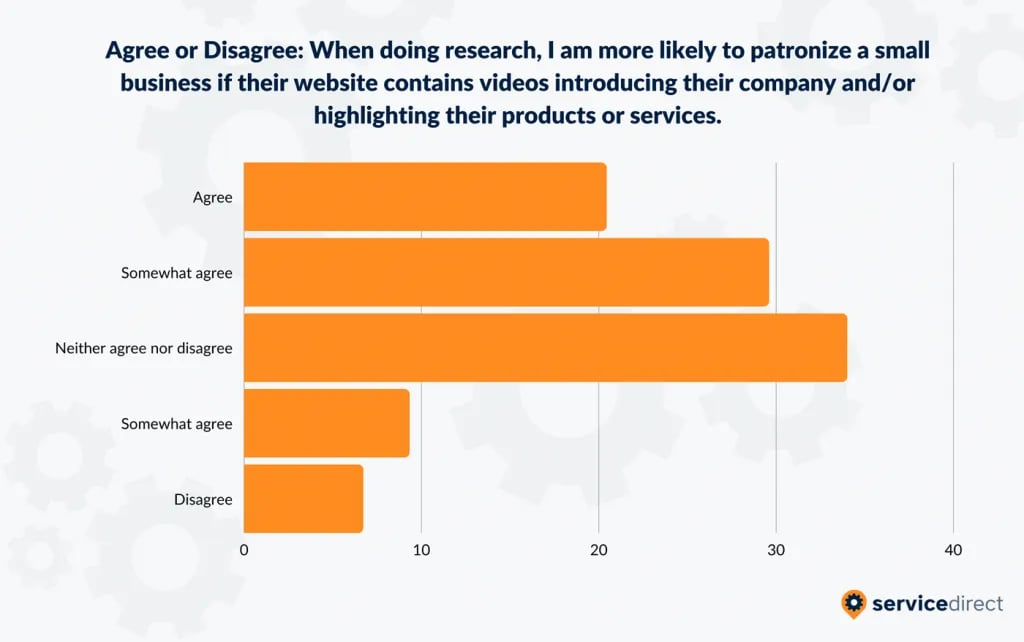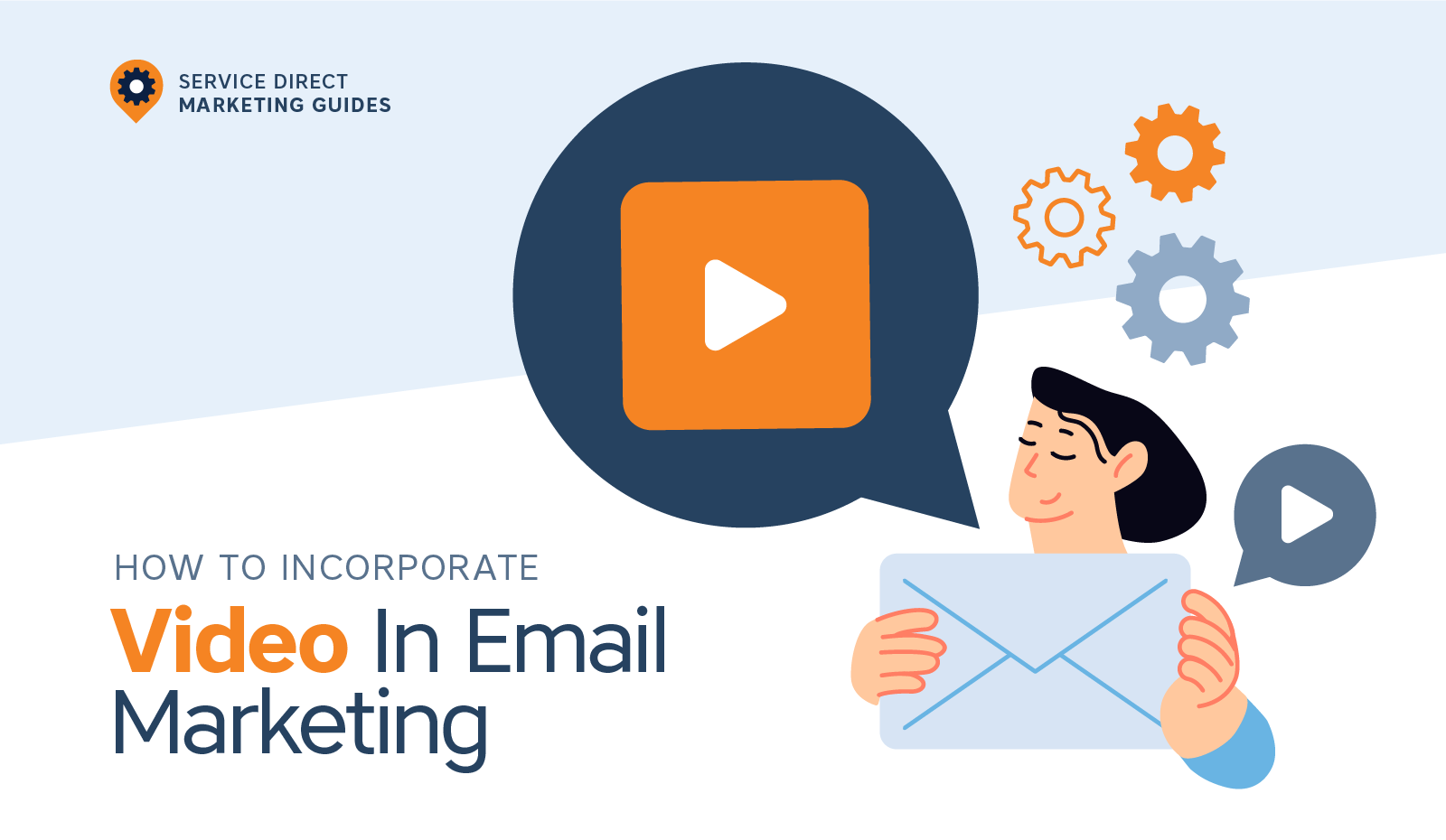How to Incorporate Video into your Small Business Email Marketing Strategy
Email continues to be a popular marketing channel for businesses of all sizes. But as consumers receive more and more emails from brands, it becomes harder to stand out in your target audience’s inbox. And this is especially true for small businesses. In fact, 36% of small businesses reported that optimizing email metrics is their biggest challenge.

This leaves us with an important question – how can smaller companies improve their email metrics and stand out from competitors?
Enter: video marketing.
Over 50% of small businesses believe that video is one of the most effective types of content for achieving their marketing goals. And most consumers agree with this sentiment, as 50% say they are more likely to buy from businesses that include videos in their copy.

For this reason, this article will discuss incorporating video content into your email marketing strategy. This way, you can use video to improve the success of your email outreach efforts. Let’s get started!
Why Implement Video Email Marketing?
As the name suggests, video email marketing is the method of including videos in the body of your marketing emails. This is a powerhouse strategy since email and video are individually impactful marketing tools.
For instance, email marketing offers businesses an ROI of $36 for every $1 spent sending emails. At the same time, a vast majority of marketers feel that video directly impacts their sales in a positive way.
By combining these two powerful marketing mediums, your business stands to gain in significant ways. Here’s how video email marketing benefits businesses:
- Boosts customer engagement
- Maximizes open rates and click-through-rate (CTR)
- Drives traffic to your website
- Increases conversion rates for local and international sales
- Humanizes your brand
- Builds consumer trust
- Decreases the number of unsubscribes
- Improves customer retention
What Makes Video Such an Effective Marketing Tool?
Video allows you to connect with customers on an entirely different level than you can with written text or static imagery. And with 84% of consumers reporting that they were convinced to make a purchase after watching a brand’s video, it’s more important than ever to implement video into your marketing strategies. But what makes video such an effective marketing tool? Let’s take a look.
Convenient for Target Audiences to Consume
Many buyers don’t have the time or patience needed to read long texts or blog posts in full. With video, they don’t have to, as no reading or scrolling is required. And since the human brain registers images faster than text, videos help viewers process information more efficiently. This means even complex subjects become easier for audiences to understand and retain.
As an example, we'll use our own explainer video. In 90 seconds, we discuss pain points, walk prospects through how our software works and explain the benefits to their business. In text, it would take us an entire page worth of content to do that!
More Engaging Than Text
Videos immediately grab the audience’s attention in a way that an introduction hook never could. Simply put, text is not as engaging or entertaining as video. This is because video delivers auditory and visual cues, including body language, tone of voice, eye contact, and so on. These cues help form connections and elicit emotions from your customers, which are essential to driving engagement and conversions.
Easily Shareable Between Users
More and more social media platforms are focusing on video to keep up with their user’s preferences. With 92% of mobile viewers sharing videos with others, it’s easy to see why these platforms and other businesses are capitalizing on consumers’ demand for video. And since videos are easily shared between users, the opportunity for businesses to reach a wider audience and generate brand awareness is significant.
Builds Customer Trust
You can easily foster customer trust by using videos to showcase your brand, highlight customer testimonials, or demonstrate your products. This is because viewers witness the benefits or value of your services as well as your business’ industry experience. All of this contributes to the buyer’s decision and establishes a foundation of trust with your brand.
By incorporating video into your email marketing strategy, you can capitalize on what makes video so compelling. The result? A stronger and more successful approach to email marketing with improved KPIs to prove it.
How to Incorporate Video into Your Email Marketing Strategy
Now that we’ve covered the basics of email video marketing, let’s dive into how to start incorporating video into your email strategy. This step-by-step process works mainly for small businesses and can be scaled up to meet enterprise marketing needs.
Identify Your Marketing Needs and Goals
When considering any new marketing tactic, you must understand how it will help you achieve the results you’re looking for. To do so, start by identifying your specific marketing needs and goals. This not only enables you to stay on track to success, but also guides the implementation and execution of your video email marketing efforts.
Here are some questions to help you determine your needs and goals:
- What business objectives are you looking to support or achieve? How can video email marketing help you get there?
- How is your current email marketing strategy succeeding? What areas or metrics need improvement? How can including videos fill these gaps?
- Do your competitors include videos in their emails? If so, how are they using this tactic to achieve their goals?
- Do you plan to film, animate, produce, and edit videos in-house or outsource? If in-house, what equipment will you need?
- What is your budget? How much are you willing to spend on equipment, software, spokespeople, vendors etc.
- What is your general timeline? How many videos do you plan to produce on a weekly, monthly, or yearly basis?
Determine Target Audience Segments
It goes without saying that your target audience directly impacts which marketing strategies you pursue and how you execute them. So, before planning and producing video content, start by determining or reevaluating your target audience segments. This will help you create highly-targeted content that better addresses your customer’s specific needs and drives conversions.
Here are a few different ways to identify your target audience segments:
- Assess how and why current customers use your services or products by asking for feedback or collecting case studies
- Conduct local market research through focus groups, surveys, interviews, etc.
- Research your competitor’s social media, reviews, and targeted content to understand who they're targeting as well as where they are succeeding and falling short.
Selecting Video Content Type
Picking the right type of video to include in your email marketing strategy is imperative to reaching your goals and appealing to customers. This is because every kind of video speaks to a particular stage in the customer’s journey or serves a specific purpose. To decide what works best for you, let’s go over the 6 main types of video content:
- Educational and ‘how-to’ videos teach viewers about a new concept or service to create foundational knowledge for your audience to understand your solutions better.
Used for: onboarding customers or helping current customers understand your services.
- Product demos videos explain what your product does and showcases how it works.
Used for: convincing prospects to make a purchase.
- Brand or company videos convey your business’ identity including vision, mission, values, services, and what sets you apart from competitors.
Used for: generating brand awareness and attracting your target market.
- Case studies and testimonial videos give current customers the floor to praise your product and explain how they use it to solve their pain points.
Used for: building customer trust through social proof and customer advocacy.
- Event videos provide viewers with a glimpse of your event through highlight reels, interviews, presentations, and more.
Used for: establishing your business as an expert in your industry and promoting future events or related campaigns.
- Announcement videos update customers on new products or features, promotions, offers, policy changes, or company news.
Used for: highlighting changes to your service, generating excitement for upcoming offerings, or delivering company updates.
The type of video you select for your email copy one week might differ from the one you include the following week. Or, you might use the same type 3 weeks in a row! When producing and including videos, focus on your priorities, marketing goals, and what you want to drive viewers to do each and every time. This way, you get the most out of every video you include in your emails.
Create a Video Script
Developing scripts for your videos streamlines the production process, helps you stay on track, and ensures you don’t forget important points along the way. At this stage, it’s also much easier to edit as you go and make as many changes as you want to your script or vision.
To help you write an engaging and high-performing video script, here are some tips to consider:
- Get to the point quickly. Don’t make the viewer wait for the primary purpose of the video.
- Keep your script concise and brief, depending on your topic and video type. Sid Kumar, Head of Marketing at Exoprise, recommends, “Keep them short, around 20-30 secs. Anything beyond that feels like a longer video and can slow down email delivery.” If your topic requires a longer video, consider including a short version in the email and then a link to the full version, if the viewer wants to learn more.
- Avoid using jargon and buzzwords. If you wouldn’t say it in conversation, don’t include it.
- Brainstorm graphics, displayed texts, and other possible visuals as you write. Make a note of where they would appear. This is especially important to those creating animated videos, as it is part of the storyboarding process.
- For videos featuring people and those with only voiceovers, include breaks in your script for the speaker to take if they need one. Insert breaks where visual elements are, such as during a title slide, graphic, or animation. This way, you have a seamless video experience instead of an awkward transition or cut between takes.
- Always include a call to action (CTA) that matches your goals as well as the intent of the topic and video type.
- Read your script aloud (preferably with a teammate) to ensure it flows well and sounds natural during live voice recordings.
Produce Your Video and Edit
While sound and image quality are undoubtedly important to the viewer’s experience, your in-house filming setup doesn’t have to be complex or expensive. You can produce quality videos with basic equipment.

Fernando Lopez, Marketing Director at Circuit, elaborates, “Video builds engagement - the only deterrent is cost. Fortunately, there are simple ways to include video without blowing your budget. Shoot low-cost talking head videos with smart devices or refresh old content and embed previously-shot videos in your email. Don’t get bogged down thinking that video is too complex or costly.”
For videos featuring people and voiceovers, here’s what you need to get started:
- A mic
- A camera (most modern phone cameras work) and tripod or stabilizer
- A ring light or another type of portable light source
- A way to display your script for the speaker (consider a teleprompter app)
- A space with minimal noise, limited distractions, lots of light, and an interesting background
- A spokesperson
Some optional resources include:
- Soundproofing materials (even blankets and rugs help absorb unwanted sound)
- Additional light sources (at least 3 is ideal)
- A green screen
- Background music
Remember, your video doesn’t have to be one long, perfect take, as this often puts a lot of pressure on both the spokesperson and the filming crew. Try breaking where it makes sense in your video. And don’t forget to leave a buffer at the beginning and end of the video for editing purposes.
For those interested in creating animated videos, you’ll need:
- Animation software and tools
- An animator or design professional
- Background music
And if you plan on adding a voiceover to it, you’ll also need:
- A mic
- A quiet recording space
- A speaker
- A recording device
Once you’ve recorded or animated your footage, the next step is editing the video. If you have an in-house design team, work with them during this process to develop engaging visuals and fine-tune the video before it goes live.
Start by selecting an editing tool that works for your budget, level of expertise, and the type of video you’re creating. Some popular editing tools are:
- Apple iMovie or Final Cut Pro
- Adobe Premiere
- Movavi Video Editor Plus
- Clipchamp and so on.
Give yourself time to learn and experiment with your editing tool. Most editing solutions include a walkthrough of the product or resource materials for those learning how to use the software.
And, if you decide this process is too complicated or time-consuming for your team, you can always outsource the filming and editing process to a professional videographer.
Write Your Email and Embed Videos
The success of your video email marketing strategy wholly relies on customers opening and reading your email. So, your email subject line must be engaging and to the point.
Anup Kayastha, Owner of Height Comparison, suggests “Consider including the word ‘video’ in your subject line as part of your video email marketing strategy. Research shows that this inclusion can boost open rates by up to 20% and click through rates by as much as 68%. This small adjustment works because it triggers anticipation, intrigue and curiosity in the reader, setting your email apart inside their inbox.”
Your main email copy must also grab the reader’s attention and quickly explain why you’re reaching out to them, without revealing too much information from the video.
After you’ve got the subject line and copy down, it’s time to embed or include your video. And there are a few different options available for embedding. For those with technical skills, HTML or HTML5 code allows you to embed videos directly in your email. However, many email clients, like Google and Yahoo, don’t support this method, leaving many subscribers with nothing to watch. The most common ways to embed videos is simply by including an image or GIF that links to your video or using an email marketing software like MailChimp to add video.
Lastly, Tim Clarke, Director of Sales at SEOBlog.com, recommends enabling autoplay by embedding an autoplay code or configuring it in your email marketing software. He explains, “This is so the clip loads instantly; customers don't have to do anything on their end and are given a video preview.”
Maximize Your Success with Video Email Marketing
As you can see, incorporating video into your email marketing strategy dramatically boosts the success rate of your outreach efforts. And, you can continue to maximize and build on that success by monitoring your video email performance. Ask yourself: what's working and what's not? Then, make modifications as you see fit. You can also try A/B testing your videos to see what messaging, video types, durations, and more resonate with your audience the most. This way, you get the most out of your video email marketing strategy and craft an even better experience for your subscribers.




